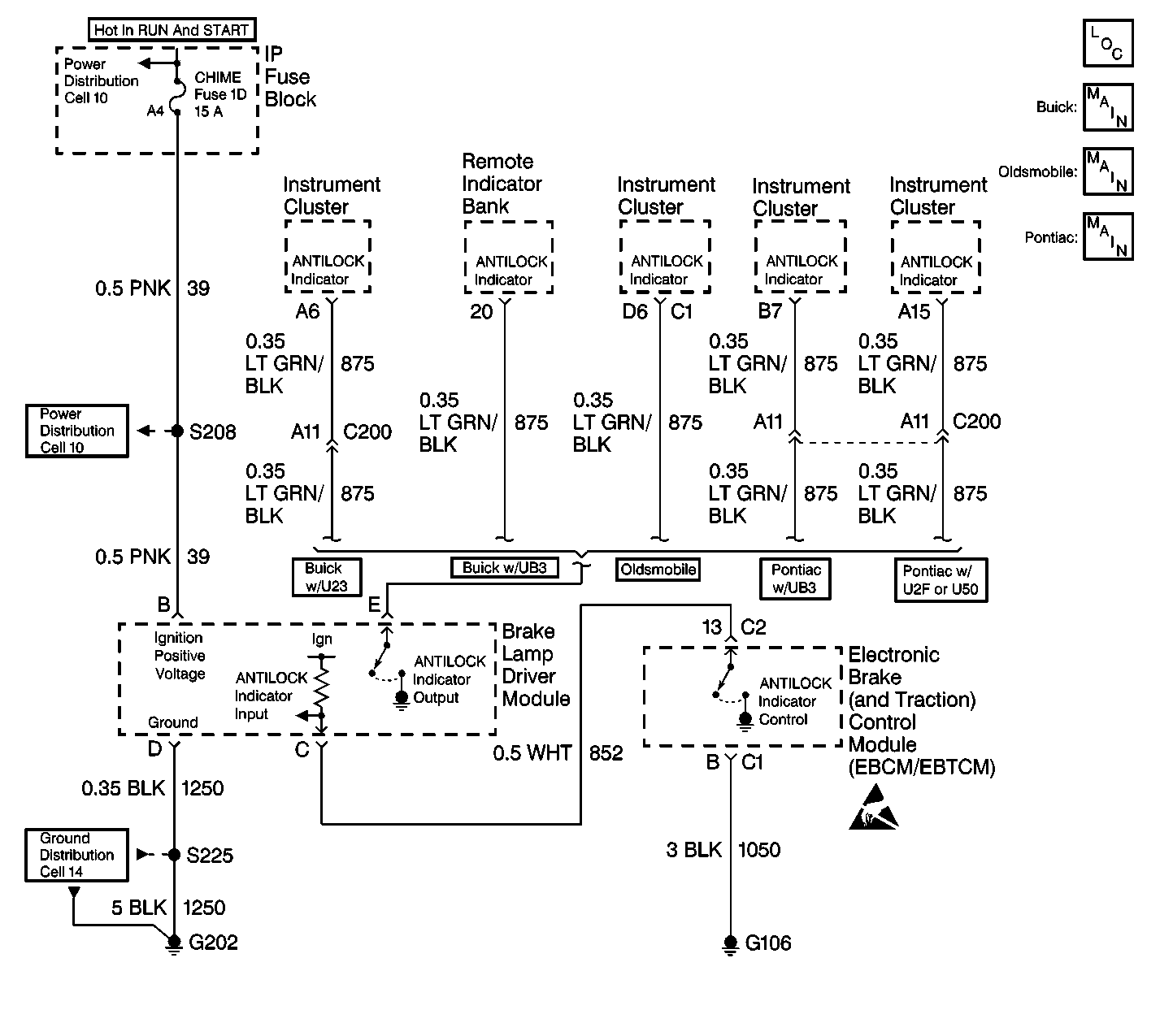
Circuit Description
The EBCM/EBTCM controls the ABS indicator through the brake lamp driver module. The instrument cluster or remote indicator bank supplies voltage to the ABS indicator. The brake lamp driver module acts as an inverter. When the EBCM/EBTCM supplies a ground to the brake lamp driver module, the indicator remains OFF. When the EBCM/EBTCM removes ground from the brake lamp driver module, the brake lamp driver module supplies ground to the ABS indicator.
Diagnostic Aids
| • | It is very important that a thorough inspection of the wiring and connectors be performed. Failure to carefully and fully inspect wiring and connectors may result in misdiagnosis, causing part replacement with reappearance of the malfunction. |
| • | An intermittent malfunction can be caused by poor connections, broken insulation, or a wire that is broken inside the insulation. |
| • | If an intermittent malfunction exists, refer to Intermittents and Poor Connections Diagnosis in Wiring Systems. |
Test Description
The number(s) below refer to the step number(s) on the diagnostic table.
-
This step inspects if the EBCM/EBTCM is not capable of removing the ground for CKT 852 (WHT).
-
This step inspects for a short to ground in CKT 39 (PNK).
-
This step inspects for voltage at the brake lamp driver module.
-
This step inspects for voltage from instrument cluster.
-
This step inspects if the brake lamp driver module has a good ground.
Step | Action | Value(s) | Yes | No |
|---|---|---|---|---|
1 | Did you perform the ABS Diagnostic System Check? | -- | Go to Step 2 | |
Does the ABS indicator turn on? | -- | Go to Step 16 | Go to Step 3 | |
3 |
Is the fuse OK? | -- | Go to Step 4 | Go to Step 5 |
4 |
Is the voltage within the specified range? | Battery Voltage | Go to Step 6 | Go to Wiring Repairs in Wiring Systems |
Is the resistance within the specified range? | OL (infinite) | Go to Step 9 | Go to Step 8 | |
Is the voltage within the specified range? | Battery Voltage | Go to Step 7 | Go to Step 17 | |
Use the J 39200 DMM in order to measure the voltage at terminal E of the brake lamp driver module harness connector. Is the voltage within the specified range? | Battery Voltage | Go to Step 10 | Go to Step 11 | |
8 | Repair a short to ground in CKT 39 (PNK). Refer to Wiring Repairs in Wiring Systems. Did you complete the repair? | -- | -- | |
9 |
Is the fuse OK? | -- | Go to Step 12 | |
Is the resistance less than the specified value? | 2 ohms | Go to Step 12 | Go to Step 13 | |
11 |
Is the resistance less the specified value? | 2 ohms | ||
12 | Replace the brake lamp driver module. Refer to Lamp Driver Module Replacement . Did you complete the repair? | -- | -- | |
13 | Repair an open in CKT 1250 (BLK) for an open. Refer to Wiring Repairs in Wiring Systems. Did you complete the repair? | -- | -- | |
14 | Repair the instrument cluster as needed. Refer to Diagnostic System Check - Instrument Cluster in Instrument Panel, Gauges and Console. Did you complete the repair? | -- | -- | |
15 | Repair an open or high resistance in CKT 875 (LT GRN/BLK). Refer to Wiring Repairs in Wiring Systems. Did you complete the repair? | -- | -- | |
16 | Replace the EBCM/EBTCM. Refer to Electronic Brake Control Module Replacement . Did you complete the repair? | -- | -- | |
17 | Repair an open or high resistance in CKT 39. Refer to Wiring Repairs in Wiring Systems. Did you complete the repair? | -- | -- |
